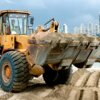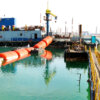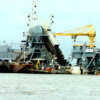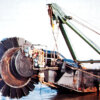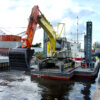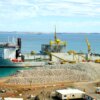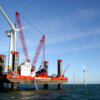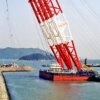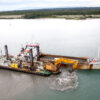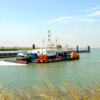A bucket ladder dredger has a series of buckets mounted on an endless loop that scoop material from the waterbed and deposit it through a chute to a barge.
Work method of the bucket-ladder dredger
The loop of the bucket-ladder dredger is powered causing the buckets to travel downwards in such a way as to scoop the material from the bottom, and then carry the material in the upright buckets up the ladder to the top. At the top the buckets rotate into an upside down position and their contents falls into a chute. The material is then sent through the chute to barges or scows alongside the dredger. As with other mechanical dredgers, barges or scows are used to transport the dredged material to the placement or relocation sites.
Bucket sizes vary from 30 liters to 1200 liters. Rock bucket dredgers may have a double set of buckets: a small rock bucket and a bigger soft soil bucket.
The bucket-ladder dredger is usually stationary but some are self-propelled and can travel on their own to the dredging site.
Types of material
Bucket-ladder dredgers can be effectively used for dredging a wide variety of materials up to and including soft rock. This includes certain specific tasks, such as removing stiff clays and weak rock layers, trench dredging and maintenance in some ports.
Limitations
Bucket ladder dredgers have been almost entirely replaced by backhoe dredgers or trailing suction hopper dredgers and cutter suction dredgers. They are less frequently used because they have relatively low production rates and need to have anchor lines, which often interfere with navigation traffic. They also have relatively high noise levels.
Their maintenance costs tend to be high and most importantly their production has not kept pace with the increase in scale that has taken place in the suction dredgers.
Project applications
Bucket dredgers are used in new or maintenance dredging projects only if the initial depth of the area to be dredged is too shallow for trailing suction hopper dredgers and if the distances involved are too long for hydraulic transport. For some environmental projects, the bucket dredger may be suitable. When dredging for construction materials such as sand and gravel or for minerals such as gold and tin ores, bucket dredgers are still used.



